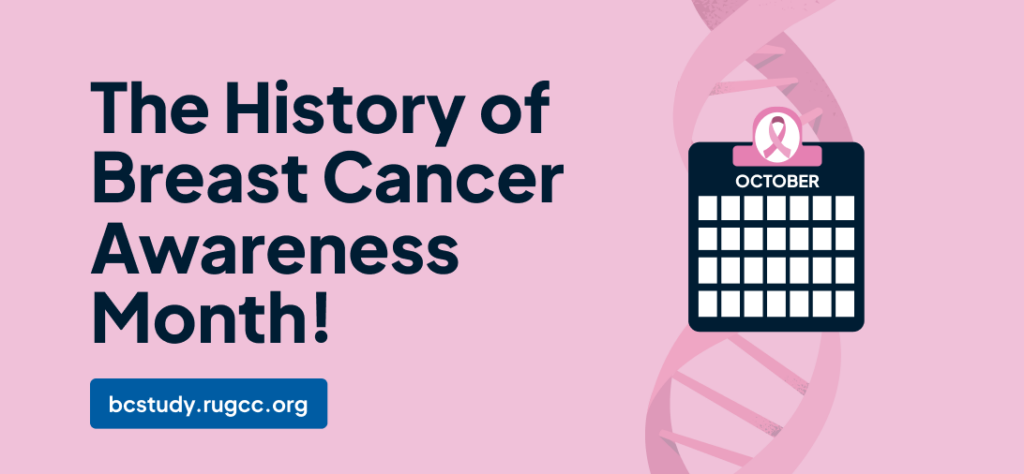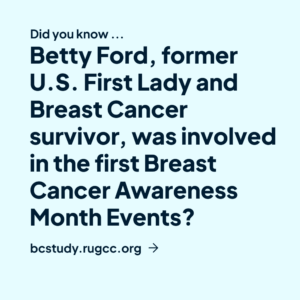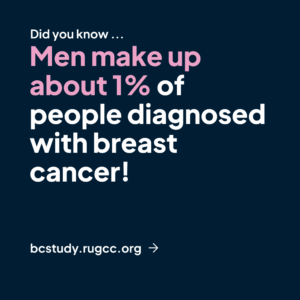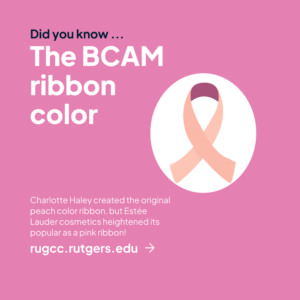
Mylie Siegel, Rutgers University, NJ
Genetic Counseling Master’s Student
October is Breast Cancer Awareness Month. During this time, advocacy groups take special initiatives to raise awareness about breast cancer and the benefits of early screening and prevention against it. Many recognize these efforts through the pink ribbons and fundraising events that are advertised. However, the widespread recognition of this tradition has not always been present. While some of us grew up hearing about breast cancer awareness, others may remember a time when such a devastating disease was not even commonly discussed. So where did Breast Cancer Awareness Month come from? And what led to its success?
In 1985, the American Cancer Society formed a partnership with the pharmaceutical division of Imperial Chemical Industries to educate women about the screening options for detecting early breast cancer. Betty Ford, former First Lady of the United States and breast cancer survivor was among several leaders who brought attention to the first week-long event that would eventually become Breast Cancer Awareness Month. They aimed to inform the public about the importance of receiving routine mammograms for early breast cancer detection and treatment, with the intention of improving the survival rates of those affected.
As the movement gained popularity, the pink ribbon became a symbol to represent breast cancer awareness. However, this well-known image actually began as a peach-colored ribbon, created by Charlotte Haley in 1991. Haley began hand-making and locally distributing her peach breast cancer ribbons as a way of advocating for the National Cancer Institute to allocate more than only 5% of its annual budget towards cancer prevention. Her endeavors gained enough traction that she was contacted by Self magazine and the Estée Lauder cosmetics company with requests to brand her ribbon for breast cancer awareness. Haley declined the request as these companies were too corporate for her, so they created the now-iconic brighter pink ribbons that are seen in marketing campaigns today instead. Charlotte Haley’s activism still played a crucial role in the rise of breast cancer awareness.
Estée Lauder handed out 1.5 million pink ribbons in 1992, launching the first nationwide campaign using this symbol and establishing its relevance as a trademark of Breast Cancer Awareness Month. The National Football League further solidified the pink ribbon’s representation of breast cancer awareness as nearly all players, coaches, and referees adorn their uniforms with a ribbon during the month of October. Today, many individuals don their own apparel with a pink ribbon to signify their struggle with breast cancer or support of a loved one who has dealt with the disease.
According to the World Health Organization, 2.3 million women globally were diagnosed with breast cancer in 2022. That year there were 670,000 deaths due to breast cancer, making it the leading cause of cancer-related death in women. While many of the marketing campaigns discussed here have historically been targeted toward women, about 1% of breast cancers occur in men. While strides have been made in advocacy for early breast cancer detection and treatment in women, men with breast cancer are still more likely to be diagnosed at later stages with fewer treatment options available to them. Although much less frequent, men who develop breast cancer experience poor outcomes of the disease at much higher rates than their female counterparts.
Despite the negative impact breast cancer can have on men, awareness campaigns and clinical trials for breast cancer treatment often do not include them. In fact, the U.S. Food and Drug Administration only recently released a recommendation for men to be included in clinical trials for breast cancer treatment medications. Many breast cancer support organizations, such as Male Breast Cancer Happens which formed in 2014, have created inclusive environments to make Breast Cancer Awareness Month more accessible to everyone who may be impacted.
The progress that has been made in breast cancer awareness has helped lead to the current work in the Study of the Genetics of Breast Cancer. Researchers at Rutgers University in partnership with Regeneron Pharmaceuticals aim to understand more about the genetic basis of breast cancer for developing drugs that will improve current treatment options. All genders are invited to participate in this research so that clinical trial outcomes will be representative of the populations who experience breast cancer. To join the study, visit https://bcstudy.rugcc.org/.
References
https://malebreastcancerhappens.org
https://www.who.int/news-room/fact-sheets/detail/breast-cancer
https://www.ncbi.nlm.nih.gov/pmc/articles/PMC7644128/
Attai D. J. (2020). Action Items for Breast Cancer Awareness Month. Journal of patient-centered research and reviews, 7(4), 291–294. https://doi.org/10.17294/2330-0698.1801
